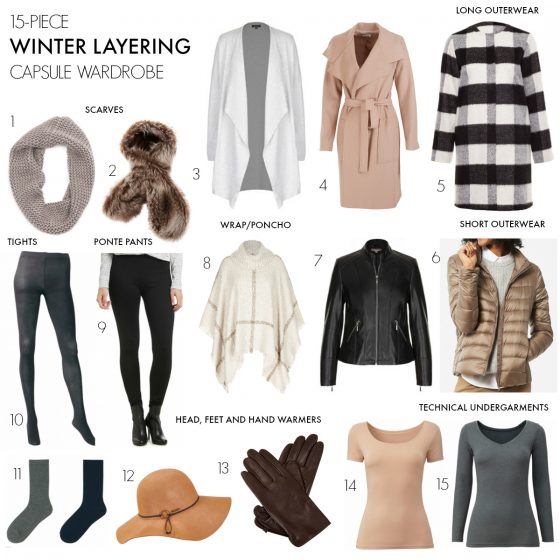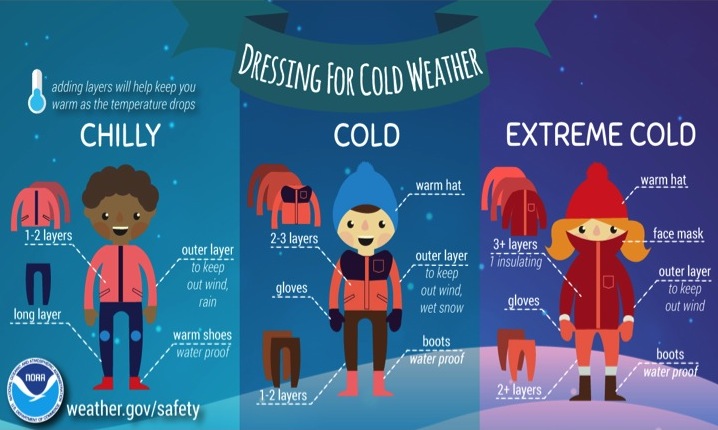Layering For Cold Weather
There are dozens of options to protect your head from cold weather and layering is a good idea in extreme cold. Once again there is a range of materials that you can choose for your insulation layer.
How To Layer Clothing And Why You Should Blog Alabama Outdoors
A note about fit.
Layering for cold weather. Cold Rainy and Hot Layering Examples. Layering For Your Upper Body. As the name suggests its role is to insulate you to keep your body heat locked inside so that you dont become cold from the external temperature.
This is the layer that traps your body heat. Some synthetics will have a finish applied to help control the odors that come with polyester. This technique is versatile and offers optimal insulation.
To layer clothes for cold weather build an outfit consisting of three essential pieces. The first step of learning how to properly layer your clothes for cold weather is understanding how to choose the perfect base layer. A layering system allows you to adjust your level of insulation and protection to correspond to the facing weather activity level and personal preferences.
If you start sweating immediately shed layers or slow down. Runners who layer smartly dress for the weather and step out the door wearing the right gear can avoid the treadmill all year round. KUIUs approach to hunting apparel centers around a.
In our case it is our clothing. Insulation Layer The next layer is the one thats going to keep you warm. That means your sweat sits on your skin until it evaporates which leaves you shivering.
Any suggestions based solely on weather though overlook key considerations like exertion level and personal metabolism. Were often asked about how to layer for certain weather. Hunting in cold weather is just as challenging as it.
Wool and silk remain good 1st layers since. Keeping a breathable moisture-wicking fabric close to your chest is essential for maintaining a normal body temperature when exposed to cold harsh weather. These are typically worn over other base layers to add warmth.
The main purpose of this bottom layer of clothing is to transfer moisture away from your skin and provide a comfortable foundation for the rest of your outfit. For the coldest weather conditions there are heavyweight base layers. Like treestand hunting the more layers the better.
In cold weather be sure to include bottoms as well such as the Merino Long John 375 from Merkel Gear. You can always take layers off and stash them in the blind or in your pack. I chose a medium weight long sleeve base layer.
A base layer such as a sweat proof shirt middle layer like wool or fleece and outer layer like a waterproof or water-resistant jacket. The first rule of cold-weather riding is to dress in layers. Use fabrics with good moisture-transfer capability so that sweat can dissipate to the outside and leave your skin relatively dry.
Different people get cold at different temperatures so work your way up to colder temperatures by learning your cold resistance and tinkering with what you wear. Shedding or adding layers is easier with bird hunting without quite the same amount of stealth needed. The ritual of adding or peeling layers to regulate becomes a necessary task.
In cooler conditions a mid weight base layer can be worn as a second layer over another base layer or on its own. Your biggest problem isnt getting cold he says. Dont forget to check our article base layers 101 for more details about base layers.
For cool or cold weather your base layer should be snug because if its not touching your skin it cant wick sweat. Its actually getting too warm and sweaty because once you stop moving hypothermia can strike in less than five minutes on cold windy days So layering is key. Once you have a few winter hikes under your belt youll see how much heat your body generates and then you can adjust your cold-weather hiking clothes accordingly.
The best base layer for extreme cold where temperatures are well below 0C or 32F during the winter or in cold climates. Layering is the process of appending something on top of another. Here is how to layer for the extreme cold weather like an expert.
The best base layer for cold weather where temperatures are near 0C or 32F. It can range from lightweight fleeces and wool sweaters. For winter layering youll want a next-to-skin base layer a mid-weight insulating layer a.
You can wear a ski mask or balaclava with an aviator hat or with a full parka snorkel hood. This layer is extremely important and you need to get a moisture wicking material such as wool.
Going Winter Trekking Here Is How To Layer Right Anthill Adventures

 Travelista Guide To Cold Weather Layering Travelista
Travelista Guide To Cold Weather Layering Travelista
 How To Layer Clothes For Cold Weather Bulk Free And Warm Jayde Archives
How To Layer Clothes For Cold Weather Bulk Free And Warm Jayde Archives
 Winter S Chill The Layering Process The Outdoor Gear Review Youtube
Winter S Chill The Layering Process The Outdoor Gear Review Youtube
 How To Layer Clothes In Winter Without Looking Bulky
How To Layer Clothes In Winter Without Looking Bulky
 How To Pack For A Cold Weather Road Trip Layer Up
How To Pack For A Cold Weather Road Trip Layer Up
 Layering For Cold Weather How To Dress For The Slopes Pro Tips By Dick S Sporting Goods
Layering For Cold Weather How To Dress For The Slopes Pro Tips By Dick S Sporting Goods
 Layering 101 How To Layer Clothing For Cold Weather
Layering 101 How To Layer Clothing For Cold Weather
 Dressing For Cold Weather Safety Committee
Dressing For Cold Weather Safety Committee
 Cold Weather Layers For My Sister
Cold Weather Layers For My Sister
 How To Dress Warm In Cold Weather Infographic Base Layer Insulating Layers Outer Protection
How To Dress Warm In Cold Weather Infographic Base Layer Insulating Layers Outer Protection
 Layering For Winter Ella S Wool
Layering For Winter Ella S Wool

Comments
Post a Comment